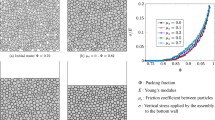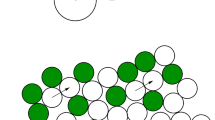Abstract
The pressure dependence of the glass-transition temperature (glass-transition lines) is described through a relationship similar to the Clausius-Clapeyron equation. The criterion for the glass-liquid transition for polymer and other glasses is calculated. According to the proposed speculations, an elementary softening event in glasses is reduced to the critical deformation of interatomic (intermolecular) linkage, which corresponds to the maximum force of attraction between atoms. A glass (an amorphous polymer) softens when the mean energy of the thermal motion of the kinetic units responsible for the viscous flow is ∼3 times higher than the work of the ultimate deformation of the interatomic bond. The nature of structural changes occurring in the course of critical displacement (excitation) of kinetic units in liquids and glasses is discussed.
Similar content being viewed by others
References
V. G. Rostiashvili, V. I. Irzhak, and B. A. Rozenberg, Glass Transition in Polymers (Khimiya, Leningrad, 1987) [in Russian].
D. S. Sanditov and G. M. Bartenev, Physical Properties of Disordered Structures (Nauka, Novosibirsk, 1982) [in Russian].
S. V. Nemilov, Thermodynamic and Kinetic Aspects of the Vitreous State (CRC, Boca Raton, 1995).
G. M. Bartenev, Dokl. Akad. Nauk SSSR 76, 227 (1951).
M. V. Vol’kenshtein and O. B. Ptitsyn, Dokl. Akad. Nauk SSSR 103, 795 (1955).
A. O. Volchek, A. I. Gusarov, and A. V. Dotsenko, Fiz. Khim. Stekla 22, 417 (1996).
R. A. Chamberlin, Phys. Rev. B: Condens. Matter 48, 15638 (1993).
A. I. Olemskoi and A. V. Khomenko, Zh. Tekh. Fiz. 70(6), 10 (2000).
D. S. Sanditov, Dokl. Akad. Nauk 390, 209 (2003).
D. S. Sanditov, Polymer Science, Ser. A 47, (2005) [Vysokomol. Soedin., Ser. A 47, 478 (2005)].
V. I. Vettegren’ and K. Yu. Fridland, Opt. Spektrosk. 38, 521 (1975).
V. A. Petrov, A. Ya. Bashkarev, and V. I. Vettegren’, Physical Principles of Forecasting of Structural Material Durability (Politekhnika, St. Petersburg, 1993) [in Russian].
D. S. Sanditov, S. S. Badmaev, T. N. Mel’nichenko, and B. D. Sanditov, Fiz. Khim. Stekla 33, 56 (2007).
Yu. V. Agrafonov, D. S. Sanditov, and Sh. B. Tsydypov, The Physics of Classical Disordered Systems (Buryat. Gos. Univ., Ulan-Ude, 2001) [in Russian].
D. S. Sanditov, Sh. B. Tsydypov, and A. N. Parfenov, Zh. Fiz. Khim. 79, 1464 (2005).
Ya. I. Frenkel’, The Kinetic Theory of Liquids (Akad. Nauk SSSR, Moscow, 1945) [in Russian].
M. P. Vukalovich and I. I. Novikov, Thermodynamics (Mashinostroenie, Moscow, 1972) [in Russian].
B. A. Belinskii, in Application of Ultraacoustics to Matter Research (Vses. Zaochn. Mashinostroit. Inst., Moscow, 1981), No. 31, p. 75.
S. V. Nemilov, Fiz. Khim. Stekla 13, 645 (1987).
N. I. Shishkin, Fiz. Tverd. Tela (Leningrad) 2, 350 (1960).
S. B. Ainbinder, E. L. Tyunina, and K. I. Tsirulya, The Properties of Polymers in Different Stressed States (Khimiya, Moscow, 1981) [in Russian].
S. Matsuoka, G. J. Aloisio, and H. E. Bair, J. Appl. Phys. 48, 4058 (1977).
P. B. Macedo and T. A. Litovitz, J. Chem. Phys. 42, 245 (1965).
D. S. Sanditov, Izv. Vyssh. Uchebn. Zaved., Fiz., No. 2, 17 (1971).
G. M. Bartenev and D. S. Sanditov, Relaxation Processes in Glassy Systems (Nauka, Novosibirsk, 1986) [in Russian].
J. Ferry, Viscoelastic Properties of Polymers (Wiley, New York, 1961; Inostrannaya Literatura, Moscow, 1963).
G. Adam and J. H. Gibbs, J. Chem. Phys. 43, 139 (1965).
D. S. Sanditov and G. M. Bartenev, Zh. Fiz. Khim. 47, 2271 (1973).
S. V. Nemilov, Dokl. Akad. Nauk SSSR 181, 1427 (1968).
B. D. Sanditov, M. V. Darmaev, D. S. Sanditov, and V. V. Mantatov, Polymer Science, Ser. A 49 (2007) [Vysokomol. Soedin., Ser. A 49, 316 (2007)].
D. S. Sanditov, Polymer Science, Ser. A 49 (2007) [Vysokomol. Soedin., Ser. A 49, 832 (2007)].
B. D. Sanditov, V. V. Mantatov, and D. S. Sanditov, Polymer Science, Ser. A 49 (2007) [Vysokomol. Soedin., Ser. A 49 1679 (2007)].
G. P. Andrianova and V. A. Kargin, Vysokomol. Soedin., Ser. A 12, 3 (1970).
M. I. Bessonov and E. V. Kuvshinskii, Zavod. Lab. 28, 504 (1962).
D. Marsh, Proc. R. Soc. London, A 282, 33 (1964).
D. S. Sanditov, Izv. Vyssh. Uchebn. Zaved., Fiz., No. 10, 110 (1969).
D. S. Sanditov, S. S. Badmaev, Sh. B. Tsydypov, and B. D. Sanditov, Fiz. Khim. Stekla 29, 5 (2003).
D. S. Sanditov, Sh. B. Tsydypov, and A. B. Bainova, Polymer Science, Ser. A 46, (2004) [Vysokomol. Soedin., Ser. A 46, 1185 (2004)].
P. D. Golub’ and M. D. Starostenkov, Tr. Udmurt. Gos. Univ., No. 10, 37 (1990).
G. M. Bartenev and A. G. Barteneva, Relaxation Properties of Polymers (Khimiya, Moscow, 1992) [in Russian].
S. Sh. Sangadiev, Candidate’s Dissertation in Mathematics and Physics (Irkutsk, 1999).
D. S. Sanditov, V. L. Mamoshin, and V. G. Arkhipov, Fiz. Khim. Stekla 19, 593 (1993).
T. N. Mel’nichenko, V. M. Rizak, and T. D. Mel’nichenko, Fiz. Khim. Stekla 29, 35 (2003).
K. Sudzuki, Kh. Fuzimori, and K. Khasimoto, Amorphous Metals (Metallurgiya, Moscow, 1987) [in Russian].
Author information
Authors and Affiliations
Corresponding author
Additional information
Original Russian Text © V.V. Mantatov, B.D. Sanditov, D.S. Sanditov, 2009, published in Vysokomolekulyarnye Soedineniya, Ser. A, 2009, Vol. 51, No. 9, pp. 1632–1642.
This work was supported by the Russian Foundation for Basic Research (project no. 05-01-00071a).
Rights and permissions
About this article
Cite this article
Mantatov, V.V., Sanditov, B.D. & Sanditov, D.S. The elementary softening event in glassy systems in terms of the model of the excited state. Polym. Sci. Ser. A 51, 1013–1022 (2009). https://doi.org/10.1134/S0965545X09090089
Received:
Revised:
Published:
Issue Date:
DOI: https://doi.org/10.1134/S0965545X09090089




